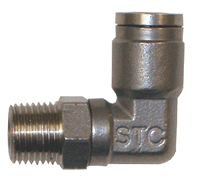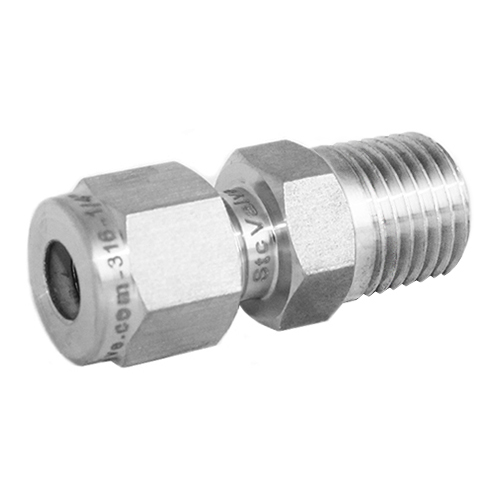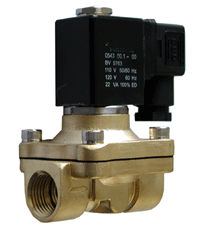|
STC's high performance direct
acting, direct-lift
diaphragm, and pilot operated piston solenoid valves offer
reliability, compact and rugged designs,
high-speed
response, long life cycle, DIN connections,
and simple installation, maintenance,
and control.
Specifications and Operation of Brass and Stainless Steel Solenoid Valves
|
Valve Model |
2HS012-032 |
2H120-150 |
2HO120-150 |
|
2L |
2LS |
|
2MS |
2MSO |
2P025 |
2P035 |
|
Valve Type
Normally Closed (NC)
Normally Open (NO) |
2 Way |
2 Way |
2 Way |
|
2 Way |
2 Way |
|
2 Way |
2 Way |
2 Way |
3 Way |
|
NC |
NC |
NO |
|
NC |
NC |
|
NC |
NO |
NC |
NC |
|
Direct
Acting |
Pilot
Diaphragm |
Pilot
Diaphragm |
|
Direct Lift
Piston |
Direct Lift
Piston |
|
Pilot
Piston |
Pilot
Piston |
Direct
Acting |
Direct
Acting |
|
Operating
Pressure (PSI) |
0 to 1000 |
5 to 1000 |
5 to 725 |
|
0 to 210
|
0 to 150 |
|
7 to 230
|
7 to 230
|
0 to115 |
0 to150 |
|
Operating
Temperature (°C) |
0 to 85°C
|
-10 to 150°C
|
-10 to 150°C
|
|
-20 to 180°C
|
-20 to 180°C
|
|
-20 to 180°C
|
-20 to 180°C
|
-5 to 80°C
|
-5 to 80°C
|
|
Port Size (NPT) |
1/8 |
3/8 to 1/2 |
3/8 to 1/2 |
|
3/8 to 2 |
3/8 to 2 |
|
3/8 to 2 |
3/8 to 2 |
1/8 to 1/4 |
1/8 to 1/4 |
|
Body Materials |
Stainless
Steel |
Brass
|
Brass
|
|
Brass
|
Stainless
Steel |
|
Stainless
Steel |
Stainless
Steel |
Engineered
Plastic |
Engineered
Plastic |
|
Seal Materials
NBR (Options:
EPDM, Viton) |
Teflon |
Viton |
Viton |
|
PTFE |
PTFE |
|
PTFE |
PTFE |
NBR |
NBR |
|
Coil Protection
Insulation Class |
H Class IP65
|
H Class IP65
|
H Class IP65
|
|
H Class IP65
|
H Class IP65
|
|
H Class IP65
|
H Class IP65
|
B Class IP65
|
B Class IP65
|
|
Coil Duty
|
100% ED
|
100% ED
|
100% ED
|
|
100% ED
|
100% ED
|
|
100% ED
|
100% ED
|
100% ED
|
100% ED
|
|
Coil Power
|
14W |
9 W, 17VA |
9 W, 17VA |
|
35W |
15 W, 22VA |
|
15 W, 22VA |
15 W, 22VA |
6.5W |
6.5W |
|
Electrical
Connections |
Conduit |
DIN |
DIN |
|
DIN |
DIN |
|
DIN |
DIN |
DIN |
DIN |
|
Service |
Air, Gas,
Liquid |
|
Air, Liquid,
Steam |
|
Air, Liquid,
Steam |
Air, Liquid,
Vacuum |
|
Valve Model |
2S025-040 |
2S160-500 |
2SO160-500 |
2T |
2V025 |
2V130-250 |
2W025-040 |
2W160-500 |
2WO160-500 |
3S035 |
|
|
Valve Type
Normally Closed (NC)
Normally Open (NO) |
2 Way |
2 Way |
2 Way |
2 Way |
2 Way |
2 Way |
2 Way |
2 Way |
2 Way |
3 Way |
3 Way |
|
NC |
NC |
NO |
NC |
NC |
NC |
NC |
NC |
NO |
NC |
NC |
|
Direct
Acting |
Direct Lift
Diaphragm |
Direct Lift
Diaphragm |
Direct Lift
Diaphragm |
Direct
Acting |
Pilot
Diaphragm |
Direct
Acting |
Direct Lift
Diaphragm |
Direct Lift
Diaphragm |
Direct
Acting |
Direct
Acting |
|
Operating
Pressure (PSI) |
0 to150 |
0 to150 |
0 to150 |
0 to 22 |
0 to 115 |
4 to 115 |
0 to 150 |
0 to 150 |
0 to 150 |
0 to 150 |
0 to 150 |
|
Operating
Temperature (°C) |
-5 to 80°C
|
-5 to 80°C
|
-5 to 80°C
|
-20 to 80°C |
-5 to 80°C |
-5 to 80°C |
-10 to 80°C |
-10 to 80°C |
-10 to 80°C |
-10 to 120°C
|
-10 to 80°C |
|
Port Size (NPT) |
1/4 to 3/8 |
3/8 to 2 |
3/8 to 2 |
1/4 to 1/2 |
1/8 to 1/4 |
3/8 to 1 |
1/4 to 3/8 |
3/8 to 2 |
3/8 to 2 |
1/8 to 1/4 |
1/8 to 1/4 |
|
Body Materials |
Stainless
Steel |
Stainless
Steel |
Stainless
Steel |
Teflon |
Aluminum |
Brass |
Brass |
Brass |
Brass |
Stainless
Steel |
Brass |
|
Seal Materials:
NBR
(Options: EPDM, Viton) |
NBR |
NBR |
NBR |
Teflon |
NBR |
NBR |
NBR |
NBR |
NBR |
Viton |
NBR |
|
Coil Protection
Insulation Class |
H Class IP65
|
H Class IP65
|
H Class IP65
|
H Class IP65
|
B Class IP65
|
B Class IP65
|
H Class IP65
|
H Class IP65
|
H Class IP65
|
H Class IP65
|
H Class IP65
|
|
Coil Duty
|
100% ED
|
100% ED
|
100% ED
|
100% ED
|
100% ED
|
100% ED
|
100% ED
|
100% ED
|
100% ED
|
100% ED
|
100% ED
|
|
Coil Power
|
14-20W |
20-35W |
30W |
20W |
6.5W |
6.5W |
14 to 20W |
20-35W |
30W |
14W |
14W |
|
Electrical
Connections |
DIN |
DIN |
DIN |
DIN |
DIN |
DIN |
DIN |
DIN |
DIN |
DIN |
DIN |
|
Service |
Air, Gas,
Liquid, Vacuum |
Gas, Liquid
|
Air, Gas,
Liquid, Vacuum |
|
NORMALLY CLOSED valves OPEN when the coil is energized.
NORMALLY OPEN valves CLOSE when the coil is energized.
The PILOT VALVE is normally open on piston pilot operated solenoid
valves. The PISTON opens only with application of PRESSURE.
Seal
Options:
NBR: -5°C
to 80°C,
EPDM: -20°C
to 120°C,
VITON: -10°C to
150°C,
PTFE: -10°C
to 180°C.
ALL Standard valves are supplied with CONTINUOUS DUTY COILS
of the proper class of insulation for the service indicated on the
valve. The coil temperature may become hot after being energized for
extended periods, but it is normal. Smoke or burning odor
indicates excessive coil temperature and should disconnect the power to the
coil immediately.
VOLTAGES:
Standard: 12-24V DC and 24-110-220-230V/50-60 Hz AC. Voltage tolerances:
+10% –5% for DC, +10%-15% for AC; .
SERVICE LIFE:
The service life of the solenoid valve depends on the operating conditions
such as pressure, temperature, type of medium and the voltage. Normally the
STC solenoid valves are reliable for more than 1 million cycles. |
| |
|
2P025, 2V025, 2S025-040, 2W025-040 are DIRECT
ACTING solenoid valves and do not require a minimum operating differential
pressure. When the coil is energized, it lifts the solenoid plunger, which
is mechanically connected to the valve seat and lifts it to open the main
valve orifice. When the coil is de-energized, spring force and media flow
return the valve seat to close the main valve orifice.
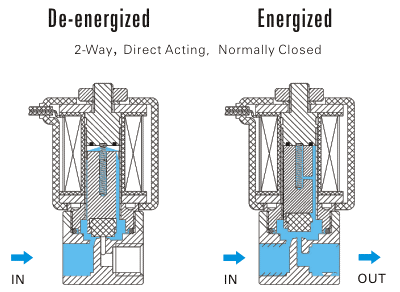
 |
|
UNIT=MM
 
|
|
 
|
|
|
|
2/2 Direct
Acting Normally Open (2P035, 2V035,
2SO025-040, 2WO025-040 Series)
To close: when the valve is energized, it attracts the plunger. Then the
plunger covers the main orifice which stops media flow through the valve.
To open: when the valve is de-energized, it releases its hold on the
plunger. Then the plunger uncovers the main orifice which allows the flow
through the valve.
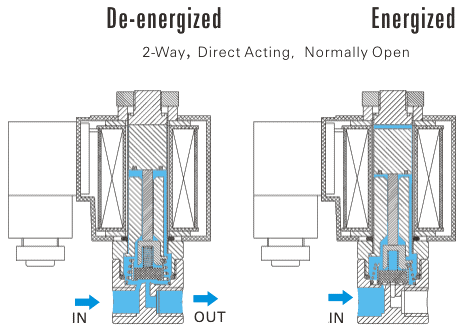 . .

|
|
2/3 Direct Acting Solenoid Valve Normally Closed (3S035 Series)
As shown in the diagram below, when
the valve is de-energized (left diagram), the plunger under the force of spring
seals the
main orifice, which makes CYL connect with EX. When the valve is energized
(right diagram), the coil
magnetic force pulls back the plunger and closes EX connection, now IN
opens to CYL.
 

|
| |
|
2W series
2/2 Direct Lift Diaphragm Normally Closed Solenoid Valve:
To open: when the valve
receives an electrical signal, a magnetic field is formed which attracts the
plunger covering the main orifice to lift off, causing system pressure to
drop. As system pressure on the top of the diaphragm is reduced, full system
pressure on the other side of the diaphragm acts to lift the diaphragm away
from the main orifice, which allows media to flow through the valve. Since
the bleed orifice is dimensionally smaller than the pilot orifice, the
system pressure cannot rebuild on the top of the diaphragm as long as the
pilot orifice remains open. When the system pressure is 0 PSI, the valve
also can be operated.
To close: when the valve is de-energized, it releases its hold on the
plunger. Then the plunger forced by the spring drops and covers the main
orifice. The system pressure builds up on the top of the diaphragm through
the bleed orifice, forcing the diaphragm down until it covers the main
orifice and stops media flow through the valve. When the system pressure is
0 PSI, the valve still can be operated.


|
|
MODEL: 2S160-500 & 2W160-500 Series SOLENOID VALVE DIMENSIONS
(MM) |
|
BRASS |
STAINLESS STEEL |
Port (NPT) |
Cv |
A |
B |
C |
D |
E |
F |
W (lb) |
|
2W160-10 |
2S160-10 |
3/8" |
4.8 |
101.5 |
57 |
117 |
69 |
36 |
56 |
1.6 |
|
2W160-15 |
2S160-15 |
1/2" |
4.8 |
101.5 |
57 |
117 |
69 |
36 |
56 |
1.8 |
|
2W200-20 |
2S200-20 |
3/4" |
7.6 |
107.0 |
57 |
124 |
73 |
36 |
56 |
1.8 |
|
2W250-25 |
2S250-25 |
1" |
12 |
111.5 |
74 |
135 |
99 |
36 |
56 |
3.2 |
|
2W350-35 |
2S350-35 |
1 1/4" |
24 |
142.0 |
95 |
172 |
123 |
63.5 |
66.5 |
5.7 |
|
2W400-40 |
2S400-40 |
1 1/2" |
29 |
142.0 |
95 |
172 |
123 |
63.5 |
66.5 |
5.7 |
|
2W500-50 |
2S500-50 |
2" |
48 |
172.0 |
123 |
209 |
168 |
63.5 |
66.5 |
9.9 |


Brass Valve
Stainless Steel Valve |
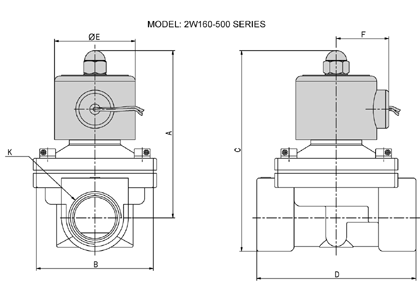 |
|
|
|
2W Series
2/2 Direct Lift Diaphragm Normally Open Solenoid Valve:
To close: when the valve is energized, it
attracts the plunger. Then the plunger covers the main orifice. The system
pressure builds up on the top of the diaphragm/piston through the bleed
orifice, forcing the diaphragm/piston down until it covers the main orifice
and stops media flow through the valve. When the system pressure is 0 PSI,
the valve also can be operated.
To open: when the valve is de-energized, it releases its hold on the
plunger. The plunger uncovers the pilot orifice causing system pressure
holding the diaphragm/piston closed to drop. As system pressure on the top
of the diaphragm/piston is reduced, full system pressure on the opposite
side of the diaphragm/piston acts to lift the diaphragm/piston away from the
main orifice, which allows the full media flow through the valve. When the
system pressure is 0 PSI, the valve also can be operated.
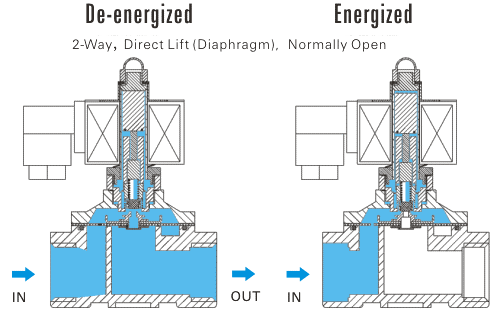
 |
|

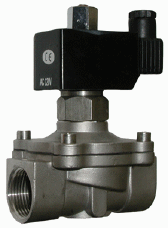
Brass or Stainless Steel Body
Normally open
Temperature: -10 to 80 Deg, C
Pressure: Vacuum to150PSI |
 
|
MODEL
Stainless Steel |
MODEL
Brass |
PORT NPT |
L (MM) |
H (MM) |
Cv |
|
2SO160-1/4 |
2WO160-1/4 |
1/4" |
40.5 |
75 |
|
|
2SO160-3/8 |
2WO160-3/8 |
3/8" |
69 |
117 |
4.8 |
|
2SO160-1/2 |
2WO160-1/2 |
1/2" |
69 |
117 |
4.8 |
|
2SO200-3/4 |
2WO200-3/4 |
3/4" |
73 |
123.5 |
7.6 |
|
2SO250-1 |
2WO250-1 |
1" |
99 |
134.5 |
12 |
|
2SO350-1 1/4 |
2WO350-1 1/4 |
1 1/4" |
123 |
195 |
24 |
|
2SO400-1 1/2 |
2WO400-1 1/2 |
1 1/2" |
123 |
195 |
29 |
| 2SO400-2 |
2WO500-2 |
2" |
168 |
227 |
48 |
|
|
|
2L Series
2/2 Direct Lift Piston Normally Closed Solenoid Valve:
Description & Operation:
2L, 2LS
series valves are 2 way normally closed, internal DIRECT LIFT PISTON solenoid valves and require
ZERO OPERATING PRESSURE
DIFFERENTIAL. When the coil is energized, it lifts the pilot valve off the
pilot valve seat, opening the pilot orifice through the center of the piston to
the outlet side of the valve. This relieves the pressure from the top of the
piston ring and pressure under the piston ring forces the piston up to open
the main valve orifice. When the coil is de-energized, the pilot valve
returns to close the pilot orifice and pressure across the piston ring is
equalized through a timing orifice in the side of the piston or in the valve
body. The piston spring returns the piston to close the main valve orifice.
|
|

Temperature: -15 to 120 Deg, C
Pressure: 0 to 210PSI
Installation: Vertical
Material Options:
Brass
Stainless Steel
|


|
|
|
MODEL: 2L Series (UNIT=MM) |
PORT CENTER LINE
TO TOP |
WIDTH |
HEIGHT |
LENGTH |
K Port (NPT) |
|
2L170-10 |
125 |
42 |
146 |
82 |
3/8 |
|
2L170-15 |
125 |
42 |
146 |
82 |
1/2 |
|
2L170-20 |
125 |
42 |
146 |
82 |
3/4 |
|
2L200-25 |
136 |
52 |
162 |
91 |
1 |
|
2L300-35 |
148 |
74 |
185 |
111 |
1 1/4 |
|
2L300-40 |
148 |
74 |
185 |
111 |
1 1/2 |
|
2L500-50 |
176 |
86 |
223 |
163 |
2 |
|
|
|
|
|
2V130 Series 2/2 Pilot Operated
Diaphragm Solenoid Valve NC
To open: when the valve receives an electrical signal, a magnetic field is
formed which attracts the plunger covering the pilot orifice to lift off,
causing system pressure (holding the diaphragm/piston closed) to drop. As
system pressure on the top of the diaphragm/piston is reduced, full system
pressure on the other side of the diaphragm/piston acts to lift the
diaphragm/piston away from the main orifice, which allows media flow through
the valve. Since the bleed orifice is dimensionally smaller than the pilot
orifice, the system pressure can t rebuild on the top of the
diaphragm/piston as long as the pilot orifice remains open.
To close:
when the valve is de-energized, it releases its hold on the plunger. Then
the plunger drops and covers the main orifice. The system pressure builds up
on the top of the diaphragm/piston through the bleed orifice, forcing the
diaphragm/piston down until it covers the main orifice and stops media flow
through the valve

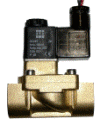 
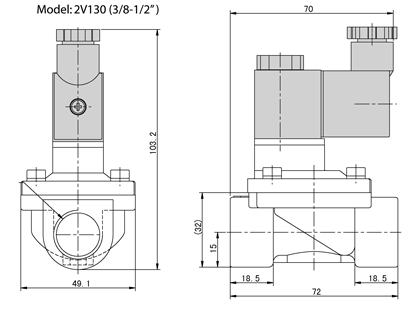
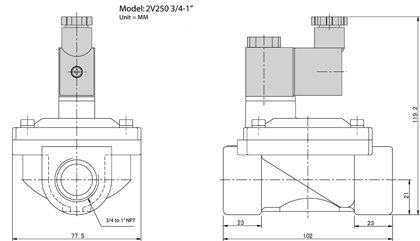 |
2V130 Series 2/2
Pilot Operated Diaphragm Solenoid Valve NO
To close: when the valve is energized, it
attracts the plunger. Then the plunger covers the pilot orifice. The system
pressure builds up on the top of the diaphragm/piston through the bleed
orifice, forcing the diaphragm/piston down until it covers the main orifice
and stops media flow through the valve.
To open: when the valve is de-energized, it
releases its hold on the plunger. The plunger uncovers the pilot orifice
causing system pressure holding the diaphragm/piston closed to drop. As
system pressure on the top of the diaphragm/piston is reduced, full system
pressure on the opposite side of the diaphragm/piston acts to lift the
diaphragm/piston away from the main orifice, which allows the full media
flow through the valve.

 |
|
|
|
|
2H1 Series High Pressure 2 Way Pilot Operated
Diaphragm NC Solenoid Valve, 5
to 1000 PSI
 |
2H2 Series High Pressure 2 Way Pilot Operated Diaphragm NO Solenoid Valve, 5
TO 725 psi
 |
| |
|
 |
 |
|


